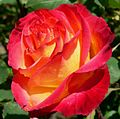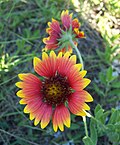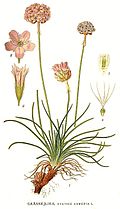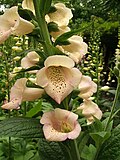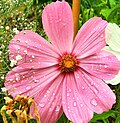AY Honors/Flower Arrangement/Answer Key
From Pathfinder Wiki
< AY Honors | Flower ArrangementAY Honors/Flower Arrangement/Answer Key /
Revision as of 19:17, 12 June 2013 by Bluescifiworm (talk | contribs) (→1. Name six perennials and six annuals suitable for indoor flower arrangement.)
1. Name six perennials and six annuals suitable for indoor flower arrangement.
| Perennials | Annuals |
|---|---|
|
|
Perennials
Annuals
2. Name at least three flowers that bloom in the spring or early summer suitable for indoor flower arrangement.
Rose, Daffodil, Statice, Calla Lily, Snapdragon, Columbine, Iris, Baby's Breath.
3. Name at least three flowers that do not keep well when cut, and three that do.
Don't keep well: Poppy, Petunia, Morning Glory, Daisy, Dahlia.
Keep well: Rose, Statice, Calla Lily, Baby's Breath.
4. Give six suggestions regarding the cutting of flowers and their aftercare, such as when to cut, how to cut, and how to keep.
- Cut flower stems with a sharp knife or pruners.
- Do NOT use scissors as they can pinch and damage the stem tissue, decreasing the flower's ability to take in water and nutrients. 3. Stems should be cu at a 45º angle. This allows for more water and nutrient intake.
- Cut flowers in early morning or evening when cooler.This helps to limit flower wilting due to humidity.
- Place cut stems in water as soon as possible. This helps to prevent drying out or wilting.
- When storing flowers in buckets or vases, do not overfill with flowers, to allow for air circulation.
- Always store flowers with cut end in water. Never submerge blooms or foliage.
- Remove any foliage that would be submerged in water once the flower is placed in its display container.
- Always remove foliage and cut flower stems with a sharp knife or pruners. Never strip foliage by hand or shorten the stems by breaking them. This damages the tissues that help the flower take in water.
- Be sure to change water daily.
- To help flowers keep longer, store in a cool place in your home (mudroom, etc.), or in your refrigerator (Approximately 35º F).
- If storing in your refrigerator, be sure to keep separate from ay fruits. Some fruits release gases that can cause the flowers to brown and ages faster.
- A Preservative may also be added to the water. There are many that are commercially available, but you can make your own using one part sugar to 3 parts water.
5. At what stage of development should roses, gladioluses, and dahlias be cut?
- Roses
- Cut when petals are half-open. This allows for the rose to open fully after harvest.
- Gladioluses
- Cut when 3/4 of the flowers have opened. Cut a spike that contains 1-4 open blooms on it. Harvest in early morning before stalks dry and leave 3-4 leaves on on plant harvested from to allow for the plant to produce the following year.
- Dahlias
- Cut when flowers are almost fully open. Harvesting sooner may cause them not to open at all.
6. Give three suggestions on the relation of containers to the flowers used, and three on the relation of arrangement to the room and furnishings.
- Containers
- Some flowers are considered to be more suited to more ornate containers, and some to simple. For instance, if you were doing an arrangement with uses, use Glass or ceramic containers. For wildflowers such as daisies, use wicker or plastic. Use bowls or short baskets for short flowers. Use baskets for silk flowers or flowers like daisies. Use tall vases for tall flowers.
The size and shape of the container and arrangement also depends on it's intended use.
- Small arrangements like the Mound can be used on end tables or as accent pieces.
- Triangular arrangements are often used as altar centerpieces or as focal pieces along walls to add visual interest to the blank space.
- Asymmetrical arrangements work best in shallow containers and are often used as focal points in entryways, on mantels, and on the end of buffet tables.
- The Crescent is similar to the Asymmetrical arrangement. Low, oblong or oval containers are often used, and it is placed in similar locations to the Asymmetrical arrangements.
- The Hogarth Curve is an attention-grabber. it is often displayed prominently in tall vase or as a door or wall piece.
- Room furnishings
- Use large arrangements for table center pieces. Use small arrangements for side or end tables. Flower colors should contrast with the wall colors.
7. In flower arrangement, what should be the relation of dark and light shades, large and small flowers, open and partly open flowers?
- Use dark flowers in front of light backgrounds.
- Use light flowers in front of dark backgrounds.
- Use large flowers as the center focus flowers in an arrangement.
- Use small flowers as filler flowers in an arrangement near the vase's edges. Use open flowers as the center focus flowers in an arrangement.
- Use partly open flowers as filler flowers in an arrangement near the vase's edges.
- Also, use large flowers to construct the primary angles and focal points.
8. Make two artistic flower arrangements in each of the following areas: (Fresh or silk flowers may be used.)
- a. Table decoration
- b. General house use
- c. Public service
9. What are some wild flowers that could be used in arrangements for the home? What combinations of these flowers can be used?
Wildflowers that can be used include wild rose, daisy, blanket flowers, sunflowers and wild sweet peas. Use wildflowers whose sizes and colors complement each other.
